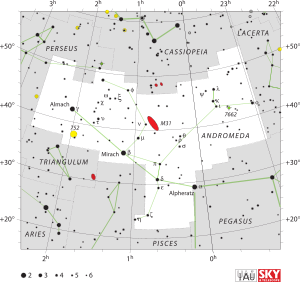Omega Andromedae
 | |
| Observation data Epoch J2000 Equinox J2000 | |
|---|---|
| Constellation | Andromeda |
| Right ascension | 01h 27m 39.38177s[1] |
| Declination | +45° 24′ 24.0727″[1] |
| Apparent magnitude (V) | +4.83[2][3] |
| Characteristics | |
| Spectral type | F5 IVe[4] or F3 V + F5 V[5] |
| U−B color index | +0.00[3] |
| B−V color index | +0.42[3] |
| Astrometry | |
| Radial velocity (Rv) | +14.7[2] km/s |
| Proper motion (μ) | RA: +356.99[1] mas/yr Dec.: –109.40[1] mas/yr |
| Parallax (π) | 34.94 ± 0.31[1] mas |
| Distance | 93.3 ± 0.8 ly (28.6 ± 0.3 pc) |
| Absolute magnitude (MV) | +2.57[2] |
| Details | |
| ω And A | |
| Mass | 0.963±0.049[5] M☉ |
| Radius | 2.2[6] R☉ |
| Luminosity | 7.1[7] L☉ |
| Temperature | 6,628[7] K |
| Metallicity [Fe/H] | –0.16[2] dex |
| Rotational velocity (v sin i) | 57.1[8] km/s |
| Age | 2.1[2] Gyr |
| ω And B | |
| Mass | 0.860±0.051[5] M☉ |
| Other designations | |
| Database references | |
| SIMBAD | data |
Omega Andromedae (ω And, ω Andromedae) is the Bayer designation for a binary star[9] system in the northern constellation of Andromeda. Based upon parallax measurements made during the Hipparcos mission, this system is located at a distance of approximately 93.3 light-years (28.6 parsecs) from Earth. The apparent visual magnitude of Omega Andromedae is +4.83,[2] which makes it bright enough to be seen with the naked eye.
The primary component of this system has a stellar classification of F5 IVe.[4] The IV luminosity class indicates that it is probably a subgiant star that is in the process of evolving away from the main sequence as the supply of hydrogen at its core becomes exhausted. However, Abt (1985) gives a classification of F3 V, suggesting it is an F-type main sequence star.[5] The measured angular diameter of the primary star is 0.70 ± 0.03 mas.[10] At the estimated distance of this system, this yields a physical size of about 2.2 times the radius of the Sun.[6] It is emitting about seven times the luminosity of the Sun from its outer atmosphere at an effective temperature of 6,628 K.[7] This heat gives it the yellow-white hued glow of an F-type star.[11]
In 2008, the companion star was resolved using adaptive optics at the Lick Observatory. Subsequent observations showed the magnitude difference between the two stars is 3.65 ± 0.03 and they are separated by 0.669 arcseconds.[9] Abt (1985) lists the class as F5 V.[5]
References
- 1 2 3 4 5 van Leeuwen, F. (November 2007), "Validation of the new Hipparcos reduction", Astronomy and Astrophysics, 474 (2): 653–664, arXiv:0708.1752, Bibcode:2007A&A...474..653V, doi:10.1051/0004-6361:20078357.
- 1 2 3 4 5 6 Nordström, B.; et al. (May 2004), "The Geneva-Copenhagen survey of the Solar neighbourhood. Ages, metallicities, and kinematic properties of ˜14 000 F and G dwarfs", Astronomy and Astrophysics, 418: 989–1019, arXiv:astro-ph/0405198, Bibcode:2004A&A...418..989N, doi:10.1051/0004-6361:20035959.
- 1 2 3 Johnson, H. L.; et al. (1966), "UBVRIJKL photometry of the bright stars", Communications of the Lunar and Planetary Laboratory, 4 (99), Bibcode:1966CoLPL...4...99J.
- 1 2 3 "ome And". SIMBAD. Centre de données astronomiques de Strasbourg. Retrieved 2012-06-26.
- 1 2 3 4 5 Farrington, C. D.; et al. (September 2014), "Separated Fringe Packet Observations with the CHARA Array. II. ω Andromeda, HD 178911, and ξ Cephei", The Astronomical Journal, 148 (3): 8, arXiv:1407.0639, Bibcode:2014AJ....148...48F, doi:10.1088/0004-6256/148/3/48, 48.
- 1 2 Lang, Kenneth R. (2006), Astrophysical formulae, Astronomy and astrophysics library, 1 (3rd ed.), Birkhäuser, ISBN 3-540-29692-1
. The radius (R*) is given by:
- 1 2 3 do Nascimento, J. D., Jr.; et al. (July 2003), "On the link between rotation, chromospheric activity and Li abundance in subgiant stars", Astronomy and Astrophysics, 405: 723–731, arXiv:astro-ph/0307196, Bibcode:2003A&A...405..723D, doi:10.1051/0004-6361:20030633.
- ↑ Schröder, C.; Reiners, A.; Schmitt, J. H. M. M. (January 2009), "Ca II HK emission in rapidly rotating stars. Evidence for an onset of the solar-type dynamo", Astronomy and Astrophysics, 493 (3): 1099–1107, Bibcode:2009A&A...493.1099S, doi:10.1051/0004-6361:200810377.
- 1 2 Gladysz, Szymon; Christou, Julian C. (June 2009), "Reference-Less Detection, Astrometry, and Photometry of Faint Companions with Adaptive Optics", The Astrophysical Journal, 698 (1): 28–42, arXiv:0805.1870, Bibcode:2009ApJ...698...28G, doi:10.1088/0004-637X/698/1/28.
- ↑ Richichi, A.; Percheron, I.; Khristoforova, M. (February 2005), "CHARM2: An updated Catalog of High Angular Resolution Measurements", Astronomy and Astrophysics, 431: 773–777, Bibcode:2005A&A...431..773R, doi:10.1051/0004-6361:20042039
- ↑ "The Colour of Stars", Australia Telescope, Outreach and Education, Commonwealth Scientific and Industrial Research Organisation, December 21, 2004, retrieved 2012-01-16.